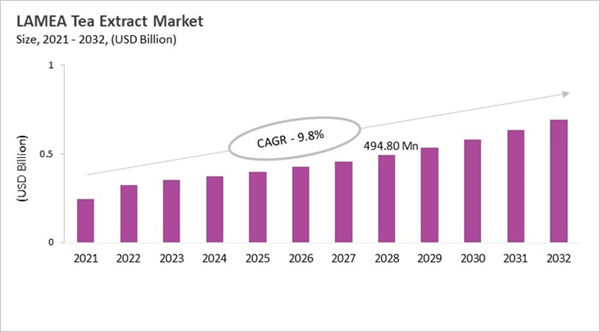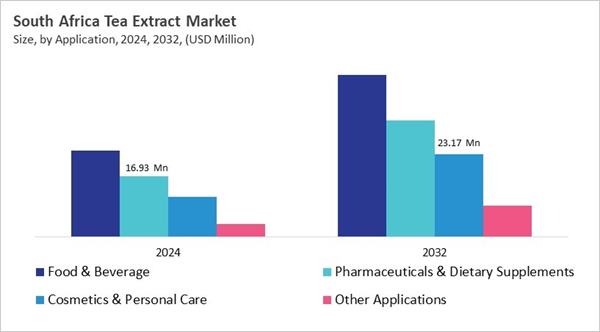The Brazil market dominated the LAMEA Tea Extract Market by country in 2024, and is expected to continue to be a dominant market till 2032; thereby, achieving a market value of $147.8 million by 2032. The Argentina market is showcasing a CAGR of 9.4% during 2025-2032. Additionally, the UAE market would register a CAGR of 7.2% during 2025-2032. The Brazil and UAE led the LAMEA Tea Extract Market by Country with a market share of 23.8% and 14.5% in 2024. The South Africa market is expected to witness a CAGR of 9.1% during throughout the forecast period.
The market for tea extracts in the Latin America, Middle East, and Africa (LAMEA) region has gradually changed from traditional tea consumption to the broad use of value-added extracts due to worldwide health and wellness trends. Demand for ethically sourced and minimally processed tea extracts that are high in bioactive compounds like polyphenols and catechins is being driven by consumers' growing preference for clean-label and organic products. The use of tea extracts has increased from dietary supplements and beverages to functional foods, cosmetics, medications, and personal care items, establishing them as adaptable, natural remedies for improving metabolism, skin health, and immunity.
LAMEA market participants are implementing strategies that emphasize product innovation, sustainability, local production, and strategic alliances. In Africa, businesses throughout the region prioritize organic farming and ecologically friendly extraction methods, while close proximity to tea plantations facilitates effective backward integration. Supported by robust quality assurance and regulatory compliance frameworks, innovation in extract formats - liquid, powder, and encapsulated forms - caters to a variety of industry needs. The market's growth prospects are still strong because of the growing demand for functional products and continuous technological advancements, despite the fact that competition is moderate and fragmented, and is driven by both global and regional players.
Form Outlook
Based on Form, the market is segmented into Powder, Liquid, and Encapsulated. The Powder market segment dominated the UAE Tea Extract Market by Form is expected to grow at a CAGR of 6.6 % during the forecast period thereby continuing its dominance until 2032. Also, The Encapsulated market is anticipated to grow as a CAGR of 8 % during the forecast period during 2025-2032.Application Outlook
Based on Application, the market is segmented into Food & Beverage, Pharmaceuticals & Dietary Supplements, Cosmetics & Personal Care, and Other Applications. With a compound annual growth rate (CAGR) of 8.4% over the projection period, the Food & Beverage Market, dominate the South Africa Tea Extract Market by Application in 2024 and would be a prominent market until 2032. The Cosmetics & Personal Care market is expected to witness a CAGR of 9.7% during 2025-2032.Technology Outlook
Based on Technology, the market is segmented into Solvent Extraction, Supercritical Fluid Extraction, Ultrasound-Assisted Extraction, and Other Technology. Among various Brazil Tea Extract Market by Technology; The Solvent Extraction market achieved a market size of USD $47.7 Million in 2024 and is expected to grow at a CAGR of 6.2 % during the forecast period. The Ultrasound-Assisted Extraction market is predicted to experience a CAGR of 7.4% throughout the forecast period from (2025 - 2032).Country Outlook
Brazil's long-standing tea and herbal culture, especially the extensive use of yerba-mate in the southern regions, has a distinctive influence on the country's tea extract market. The increasing use of tea extracts in functional foods, beverages, dietary supplements, and cosmetics is fueled by this cultural affinity, a robust agricultural foundation, and encouraging government initiatives. The popularity of ready-to-drink fortified teas, the rise in demand for energy and immunity supplements, and the use of antioxidants in cosmetic applications are some of the major trends. Advanced encapsulation technologies are becoming more popular, but liquid and powdered extracts still predominate. Local producers prioritize regional authenticity in the competitive landscape, while international players provide cutting-edge extraction technologies and extensive global distribution networks.List of Key Companies Profiled
- Synthite Industries Ltd.
- MartinBauer
- Kemin Industries, Inc.
- Tata Consumer Products Limited (Tata Group)
- James Finlay Limited
- Archer Daniels Midland Company
- AVT Natural Products Ltd
- Indena S.p.A.
- Taiyo International (Taiyo Kagaku Corporation)
- Dohler GmbH
Market Report Segmentation
By Category
- Conventional
- Organic
By Form
- Powder
- Liquid
- Encapsulated
By Type
- Green Tea Extracts
- Black Tea Extracts
- Oolong Tea Extracts
- Other Type
By Application
- Food & Beverage
- Pharmaceuticals & Dietary Supplements
- Cosmetics & Personal Care
- Other Applications
By Technology
- Solvent Extraction
- Supercritical Fluid Extraction
- Ultrasound-Assisted Extraction
- Other Technology
By Country
- Brazil
- Argentina
- UAE
- Saudi Arabia
- South Africa
- Nigeria
- Rest of LAMEA
Table of Contents
Companies Mentioned
- Synthite Industries Ltd.
- MartinBauer
- Kemin Industries, Inc.
- Tata Consumer Products Limited (Tata Group)
- James Finlay Limited
- Archer Daniels Midland Company
- AVT Natural Products Ltd
- Indena S.p.A.
- Taiyo International (Taiyo Kagaku Corporation)
- Dohler GmbH










